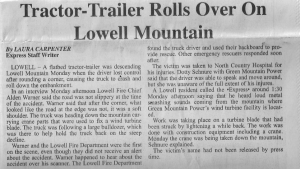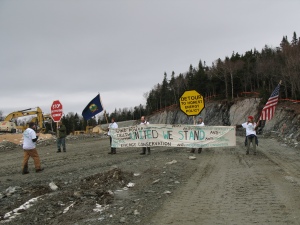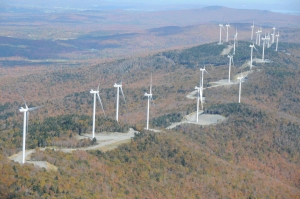Editor’s note: This commentary is by Chris Braithwaite, the publisher of the Barton Chronicle, in which it was first published on Dec. 11, 2013
The Vermont Supreme Court’s four-to-one decision against the Lowell Six is only the latest in a series of rulings that, with disturbing consistency, seem stacked in favor of a big and influential Vermont corporation — and against ordinary citizens who tried to protect a mountain they love.
The high court upheld a Superior Court jury’s verdict that the six committed the crime of trespass when they put their bodies in the way of the heavy equipment that was building Green Mountain Power’s industrial wind project on Lowell Mountain.
The issue before the high court was whether, since the ownership of the property they occupied on the morning of Dec. 5, 2011, was in dispute, and they were there with the permission of one of the claimants, they could be convicted of committing the crime of trespass.
A majority of the justices said yes, for reasons that are legally complex. But in his dissent, Justice John Dooley raised a question any layman can understand: What if the civil courts ultimately decide that the land is owned by Don and Shirley Nelson, rather than the neighbor who leased it to Green Mountain Power?
If that happens, Justice Dooley wrote, “nothing would demonstrate a miscarriage of justice more. … A criminal case is an inappropriate way for the State to resolve a boundary dispute.”
Whatever consolation they may draw from Justice Dooley’s dissent, the Lowell Six face the fact that they have taken their case to the state’s highest court, and they have lost. The turbines are spinning on Lowell Mountain, however fitfully, and the people who did their best to stop them are criminals.
The criminal case was not the first time the Lowell wind project appeared before the Supreme Court.
The Lowell Six decided it would be wiser to face arrest for trespass, on the western front of the battle, and rely on the Nelson-Wileman property dispute for their defense.
On Nov. 4, 2011, the Nelsons’ lawyer, Scott McGee, filed a “complaint for extraordinary relief” with the court. Oddly, his argument makes no reference to the disputed property line — to the still distinct possibility that Green Mountain Power (GMP) has clearcut, blown up and reshaped a substantial strip of somebody else’s land.
Instead Mr. McGee focused on the 1,000-foot deep “safety zone” that Judge Martin Maley created with the stroke of a pen less than a month earlier.
To put the confrontation between the protesters and the utility in military terms, there were two distinct fronts on the mountain, separated approximately along the ridgeline by the disputed property line between the Nelsons and Trip Wileman, who was playing host to Green Mountain Power.
On the west side of the line was the project. On the east side, undisputed Nelson property, was nothing but steep, heavily forested land dotted with a few small tents and a primitive field kitchen.
The encampment had been built in the hope that, by putting their bodies as close as legally possible to enormous blasting job that faced Green Mountain Power, protesters could bring construction to a halt.
As a criminal matter, the tactic got a clean bill of health from no less an authority than Vermont Attorney General William Sorrell. If people are there with the landowner’s permission, he said when asked by a reporter, “there’s no criminal violation that readily comes to mind.”
But as a civil matter, GMP’s very able attorney, Jeffrey Behm, didn’t see it that way. He quickly drafted a temporary restraining order that would clear the Nelson property of protesters while blasting was in progress.
He got it signed by Judge Maley under circumstances that could fairly be described as dubious.
Mr. Behm sought, and was granted, an emergency ex parte hearing before Judge Maley in St. Albans. The Latin jargon means that the other side of the dispute wasn’t present, wasn’t represented by a lawyer, indeed received no notice that the hearing was taking place.
It’s a procedure that is used, for example, when a woman is in urgent need of a court order protecting her from an abusive partner.
Mr. McGee, the Nelsons’ lawyer, raised the point in a footnote to the argument he filed with the Supreme Court:
“If no notice is given, the Rule requires that court make express findings in the order as to why the order was granted without notice. No such findings were made, and there was no justification for not notifying the Nelsons other than the improper justification of ensuring that the Nelsons would be unable to debunk GMP’s claim before the court acted on the application.”
The facts seem to bear Mr. McGee out. The “emergency,” Mr. Behm argued that Friday, was that people at the campsite would be in danger by the next Monday, Oct. 17.
I climbed the mountain the next Tuesday, Oct. 18, to find a group of protesters standing well within the forbidden “safety zone” in defiance of the judge’s order. Nobody bothered them, not the police, not anyone from Green Mountain Power. A logging crew on the other side of the property line took a break when a siren sounded its warning of a blast, but didn’t leave the area. When it happened the blast was an anticlimax, a dull report from somewhere out of sight to the south and west.
It wasn’t until Wednesday, Oct. 19, that GMP sent two of its people up to ask the protesters to leave. They didn’t, and the GMP representatives stood nearby while the blast went off at a closer, but still harmless, distance.
There was, in fact, plenty of time for Judge Maley to convene a full hearing and hear argument from both sides before making up his mind.
But the position he took on Oct. 14 became a foundation from which Judge Maley never budged as events unfolded. Here is Mr. Behm’s formulation:
“The false premise of the defendants’ scheme to destroy the project is their assumption they can do whatever they please, no matter how injurious to others, so long as they do it entirely on their own land. That misguided belief is wholly incorrect.”
But that, as Mr. McGee argued strenuously, is a matter of opinion.
As they unfolded, events got pretty interesting. By Oct. 27 blasters had come so close to the encampment that one of them warned the protesters to protect their heads and take cover behind trees. Then he let off a blast that sent clouds of dust, a few small chunks of rock, and a big rubber piece of a protective blast mat onto the Nelson property where the protesters stood.
Mr. McGee went quickly to Judge Maley’s court, seeking a temporary restraining order to halt the blasting. The errant flyrock not only constituted a trespass, he wrote, but also violated the terms of GMP’s blasting permit.
Judge Maley did not agree.
Turning to the Supreme Court, Mr. McGee urged the justices to step into a case that remained unresolved in Superior Court. If it did not, he argued, the Nelsons would soon lose their constitutional rights to occupy their own land and protest against the project.
“The superior court’s preliminary injunction effectively grants GMP a license to use the Nelsons’ property which GMP otherwise would have no right to use. This is a misuse of court power that tramples the rights of Vermont landowners to accommodate a large corporation.”
Mr. McGee cited three specific rights, under the Vermont Constitution, that the order violated:
Article I names as a “natural and inalienable right” the right of “possessing and protecting property.”
Articles 13 and 20, he argued, protect the Nelsons’ right “to assemble with others to protest GMP’s activities” and the government’s decision, through the Public Service Board, to approve the project.
Finally, Mr. McGee noted, Judge Maley’s order even denies the Nelsons their constitutional right “to hunt and fowl on the lands they hold.”
The Supreme Court declined to consider Mr. McGee’s complaint on the grounds that it wasn’t timely.
The protesters, as a tactical matter, agreed not to get themselves arrested for defying the judge, and face contempt charges. When police finally appeared on the mountain and ordered protesters to leave the safety zone, they left. (In the event, two Sterling College students who weren’t given that opportunity had the contempt charges against them dismissed by Judge Robert Gerety Jr.)
The Lowell Six decided it would be wiser to face arrest for trespass, on the western front of the battle, and rely on the Nelson-Wileman property dispute for their defense.
In hindsight, it’s hard not to speculate how, if a contempt conviction had been appealed to their court, the justices would have dealt with the constitutional issues raised by Mr. McGee.
And it’s impossible not to regret that the high court didn’t take up Mr. McGee’s complaint in the fall of 2011, when it might have preserved, not only the rights of the protesters, but Lowell Mountain itself.
Editor’s note: The author was arrested with the Lowell Six when he refused to leave the construction site before he witnessed their arrest, as a reporter. The trespass charge against him was dismissed by the court, with prejudice, in December 2012.


